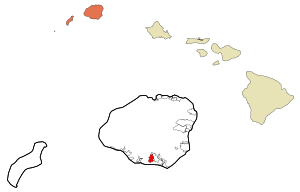Kalaheo, Hawaii facts for kids
Quick facts for kids
Kalaheo, Hawaii
Kalāheo
|
|
|---|---|

Location in Kauai County and the state of Hawaii
|
|
| Country | United States |
| State | Hawaii |
| County | Kauai |
| Area | |
| • Total | 3.54 sq mi (9.18 km2) |
| • Land | 3.50 sq mi (9.06 km2) |
| • Water | 0.04 sq mi (0.11 km2) |
| Elevation | 682 ft (208 m) |
| Population
(2020)
|
|
| • Total | 4,996 |
| • Density | 1,427.84/sq mi (551.25/km2) |
| Time zone | UTC-10 (Hawaii-Aleutian) |
| ZIP code |
96741
|
| Area code(s) | 808 |
| FIPS code | 15-24950 |
| GNIS feature ID | 0360001 |
Kalāheo is a lovely community located on the island of Kauaʻi in Hawaiʻi, United States. Its name means "the proud day" in the Hawaiian language. It's known as a "census-designated place" (CDP). This means it's an area identified by the U.S. Census Bureau for statistical purposes. It does not have its own city government. In 2020, about 4,996 people lived here. This was an increase from 3,913 people in 2000.
Kalāheo is also home to the National Tropical Botanical Garden. This special garden helps protect and study rare plants.
Contents
Exploring Kalāheo's Location
Kalāheo is found on the south side of Kauaʻi. You can find it at these coordinates: 21°55′28″N 159°31′46″W / 21.92444°N 159.52944°W. The community of Lawai is right next to it on the east side.
How Big is Kalāheo?
According to the United States Census Bureau, Kalāheo covers a total area of about 9.2 square kilometers (3.54 square miles). Most of this area is land. Only a small part, about 0.1 square kilometers (0.04 square miles), is water.
Getting Around Kalāheo
Hawaii Route 50 is a main road that goes through Kalāheo. If you travel east on this road, you'll reach Lihue in about 12 miles. If you head west, you'll get to Eleele in about 4 miles.
Understanding Kalāheo's Population
| Historical population | |||
|---|---|---|---|
| Census | Pop. | %± | |
| 2020 | 4,996 | — | |
| U.S. Decennial Census | |||
In 2000, there were 3,913 people living in Kalāheo. These people lived in 1,428 households. A household is a group of people living together in one home. Out of these, 1,039 were families.
Who Lives in Kalāheo?
Kalāheo is a diverse community. In 2000, the population included people from many different backgrounds. About 40% were White, and nearly 30% were Asian. There were also people who identified as Pacific Islander, African American, and Native American. Many residents also identified with two or more races. About 11.5% of the population was of Hispanic or Latino origin.
Families and Age Groups
In 2000, about 32.2% of households in Kalāheo had children under 18 living there. Most households, about 57.8%, were married couples living together. The average household had about 2.74 people. The average family had about 3.18 people.
The population of Kalāheo is spread across different age groups. In 2000, about 24.6% of the people were under 18 years old. About 14.8% were 65 years old or older. The average age in Kalāheo was 40 years.
Income in Kalāheo
In 2000, the typical income for a household in Kalāheo was about $57,813 per year. For families, the typical income was around $63,650. The average income per person in Kalāheo was about $23,501. A small number of families, about 1.5%, and 2.4% of the total population lived below the poverty line.
See also
 In Spanish: Kalaheo para niños
In Spanish: Kalaheo para niños

